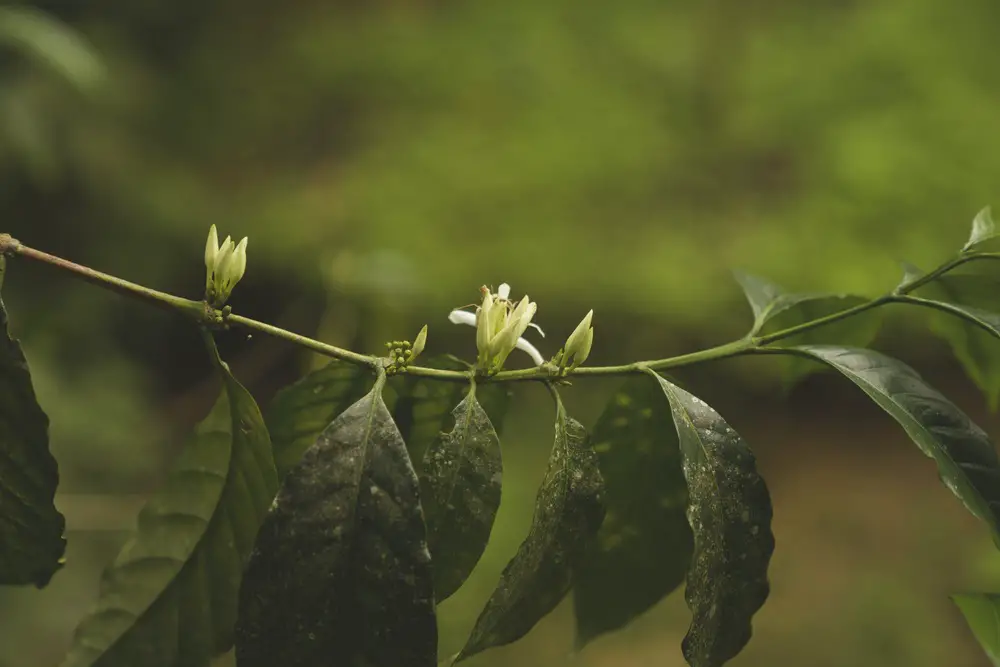When growing coffee, especially in the mountains or high-altitude areas, the weather is usually unpredictable. Many things can cause plants to wilt or die. Insects, pests, light and water conditions can cause serious problems in coffee plantations.
Plant and fungal diseases can wilt a large percentage of crops. One disease or fungus that coffee plants are commonly afflicted with is coffee rust, a harmful fungal infection that kills coffee plants if not caught in time.
Table of Contents
What is coffee rust?
Coffee rust is a type of fungus that causes yellow-brown stains and results in reddish-orange powdery structures. In the scientific world, Hemileia eats Vastatrix, the coffee rust, the living tissue of the leaves of coffee plants so that they break or fall off on their own.
This leads to a drastic reduction in the quality and quantity of the coffee cherries. It can even kill the plant if not treated in time.
The spread of this fungus is considered an epidemic, particularly in coffee farms, and is even more devastating in areas with high poverty rates that do not have the necessary means to combat it.
Lately, however, fungicides have not worked in areas that can afford to fight the epidemic.
In producing countries such as Brazil, Colombia, Honduras and other regions of the Americas, the situation is alarming and is causing coffee exports to fall.
Growing conditions
The rust spores enter the plant, usually through a natural opening or lesion on the underside of the leaf. Once invaded, the spore enters the cells in search of nutrients, kills them, and eventually produces more spores.
The new spores are expelled through the leaf openings. They are mainly spread by rain, but also by wind, animals and sometimes by humans.
Humidity
Water is essential for the propagation and germination of the spores of this fungus, and rain is necessary for a rust epidemic to occur. Some research has shown that the spores actually spread at low rates, with the main method of dispersal being by water splashing.
Temperature or climate
Under conditions that favor the disease at a temperature between 21°C and 25°C, the disease begins to germinate within 72 hours. The first symptoms can appear within the second week after infection and then urediniospores are formed from the lesions within 18 to 22 days.
How does coffee rust come about?
The exact cause of the rust is not yet known. This is due to the fact that the Coffea Arabica coffee plants and these organisms come from the same area of origin in Africa. This under conditions in which these organisms were in balance with the plants without harm to their production and survival.
The agricultural conditions in the coffee plantations with monocultures have created conditions that favor the development of the fungus as a pest or disease.
According to Precisagro, there is an 1861 observation attributed to a British researcher who mentions the occurrence of an unknown disease affecting Arabica coffee plants east of Lake Victoria in East Africa.
The famous rust chapter
In 1869 in Ceylon (now Sri Lanka), a British colony and then the leading coffee producer, the first report of the rust was described by the British scientists Berkeley and Hemileia called vastatrix.
Arabica varieties grown in Ceylon are known to have been susceptible to rust, which occurred over a period of about 20 years, when coffee cultivation had already come to a standstill.
The worldwide spread of rust
It dates back to the story of the spread of rust in Ceylon in 1869. Within a few years, the fungus spread to the tropics of Asia, where Coffea Arabica was grown.
1996: Rust is reported in Angola, West Africa.
1970: The rust arrives in Brazil and is thought to have been carried by winds from Africa to America.
1976: In less than 20 years since its arrival in Brazil, the rust has appeared in other countries of the Americas, with Nicaragua being the first country to report its occurrence in 1976.
The occurrence of rust in Nicaragua led to preventive measures in neighboring countries. However, prevention and eradication efforts have been costly and have not achieved their objective.
1978: The Regional Program for the Protection and Modernization of Coffee Cultivation (PROMECAFE) is created with the aim of increasing profitability and productivity, to allocate resources to rust control and to solve the problems of the fungus through research, technology and education.
Symptoms of coffee rust
The infections occur on the leaves of the coffee plant.
The first symptoms observed are small, pale yellow spots on the leaf surfaces. As the spots increase in size, masses of orange urediniospores appear on the undersides of the leaves.
The fungus forms its spores through stomata rather than breaking through the epidermis. The leaf powder can be red-orange to yellow-orange.
Although the lesions can develop anywhere on the leaf, they must be concentrated on the edges where dew and raindrops collect. Over time, the spots turn brown while the edges continue to expand and produce spores.
The lesions usually appear on the lower leaves and the infection slowly progresses up the coffee plant. Affected leaves fall off prematurely.
Treatment of coffee rust
Coffee rust is usually treatable with fungicides. However, this requires large investments. Also because of the increasing resistance of these fungi to treatments.
Scientists have yet to find an explanation of how coffee rust becomes immune to treatments and/or fungicides, suggesting there is no way to completely prevent it.
For these reasons, the fungus proves deadly to plants and costly to coffee farmers, negatively impacting coffee quality and production.
However, there is still no definitive remedy for coffee rust, and it is certain to have devastating consequences. However, there are some other recommendations:
- Keeping plants healthy and good hygiene practices.
- Elimination of weeds that can compete with the coffee tree for nutrients and stress the coffee plants.
- Pruning, which increases airflow through the trees and reduces humidity.
- Remove plants that are weak, old or already affected by other diseases or pests.
- There are agricultural associations or local and state representatives who can be consulted for further or better practices and recommendations.
Fungicides
Positive aspects of the use of fungicides
- In susceptible varieties and in an environment favorable to the fungus, the use of fungicides is an important tool to combat coffee rust epidemics.
- When deciding when and what to spray, each spraying is a long-term investment, not just for the current season but for future seasons as well.
- Copper-based fungicides are very effective at controlling rust. Copper has a “strengthening effect” on coffee plants which, regardless of its effect in fighting the fungus, increases yield.
- Dithiocarbamate fungicides, which are organic and protective, are effective in controlling rust and sometimes have a fortifying effect.
Negative aspects of using fungicides
Using chemical fungicides can cause some problems, such as:
- High cost of the products.
- Continued use of fungicides can encourage selection of fungicide resistant rust strains. Until now, chemical rust control has been based on only two chemical groups, which means that these products lose their effectiveness.
- Chemical residues can cause growers to abandon the high-quality organic coffee market. This is particularly the case with systemic fungicides, i.e. those that are absorbed into the plant.
- Chemical active ingredients in fungicides can harm the environment and humans.
Can you prevent coffee rust?
The answer is yes.
It is the first and only way to treat coffee rust and reduce the costs associated with this investment. Since coffee rust is a fungus that is mainly spread by rain, spray and wind, it is very difficult to find the original host that comes into contact with the coffee plant.
With timely (early) detection, quarantine of the host plant or the first infested plant and plants surrounding the infested plant is the best way to avoid widespread damage. However, the spread of the rust needs to be studied in detail because it is hardly detectable in the initial stage, which makes it difficult to prevent the spread due to the speed of its growth.
Coffee rust crisis in parts of America
Higher intensity coffee rust epidemics occurred in several countries in the Latin American region:
- Colombia: from 2008 to 2011. In Colombia, production fell by an average of 31% during the epidemic years.
- Central America and Mexico: from 2012 to 2013. Central America reduced its production by an average of 16% in 2013, compared to 10% in 2011-2012.
- Peru: In 2013
- Ecuador: in 2013 the decline in this production is affecting the lives of thousands of small farmers and harvest workers. For these populations, often the only source of income is to buy the food basket and the raw materials needed to grow coffee beans.
There are a number of important factors that have contributed to the emergence of epidemics, viz
- State of the economies of the countries
- Crop management decisions
- Prevailing climate
- Income and livelihood of coffee farmers
- Coffee production
- Food security
Cultural practices
Culture methods are any method that helps the plant to grow in its environment. Coffee does not tolerate direct sunlight. When combating coffee rust, growing under the shade of a tree is recommended, as is plant nutrition.
Reducing disease progression through shading could add value to coffee production. It could help growers to maintain not only environmental but also financial sustainability.
Coffee’s susceptibility to rust is related to its nutritional status. Therefore, plant nutrition is another important aspect of rust control.
Various sources of nutrients can be used to fertilize coffee plants. This includes growing coffee along with Crotalaria juncea (sun hemp) and/or the use of coffee pods in conjunction with castor cake or pig manure. The latter has been shown to lead to a 21-31% reduction in the number of diseases.
For plants that are in full production, nutrition should be reinforced by using products based on boron (Bo), zinc (Zn), manganese (Mn) and silicon, in addition to the traditional nutrients.
The plants use a lot of energy in the formation of coffee beans, which weakens them and makes them more susceptible to pest infestation. Therefore, farmers need to increase plant energy by supplying these nutrients.
Coffee rust control should be based on a range of integrative measures such as the use of resistant varieties, cultural practices and biopesticides. Biopesticide products should be used under the guidance of professionals. This ensures an effective and sustainable strategy to combat coffee rust.
Conclusion
The research and scientific information about coffee rust has helped to understand the ways in which rust spreads and the consequences. It affects not only the plant, but also human activities on the coffee trees.
While no definitive solution has yet been found, it is gratifying that some temporary solutions are emerging to benefit coffee farmers, most of whom do not have the resources or means to combat the disease.
I hope you learned more about coffee and its diseases. See you at one of the next guided tours.



